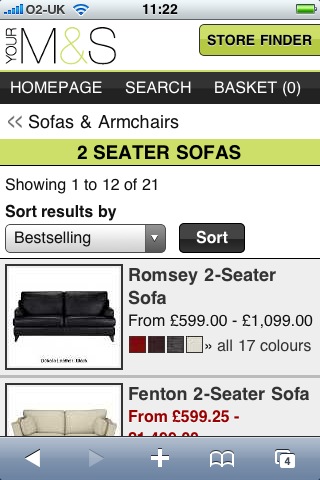Mobile payments – so far, so good…
by Sukey Miller

…but content developers need to experiment more
At a recent IAB conference in London, England, the subject of how the mobile phone concentrates a number of ways of paying was widely discussed.
The poster child mobile purchase referred to in many of the presentations, centered on a UK pounds 3000 (about $4500) purchase of a pair of sofas (aka couches – but that doesn’t work for the headline…) from UK retailer Marks and Spencer. That’s quite some buy, but the retailer has suggested that high price point purchases from mobile devices are no longer such a rarity.
At the other end of the scale, Bango presented on super-micro transactions through mobile phones – charges of just a few cents which would be decremented from a mobile-linked account, and charged through a carrier bill or other payment method. Bango’s argument was two-fold. First, that it is possible to store value against mobile identities, at relatively small amounts. In the UK market, it is cost-effective to bill through a carrier at 20 or 30 pence (less than 50 cents) so, Bango argues, a consumer can top-up with relatively small amounts of money and then accept tiny charges for consuming content.
Secondly, at such subliminal charging levels, there is a new a revenue model for content owners. The example shown featured a mobile music service called Psonar, which allows users to store collections in the cloud, then play down to any device they choose – particularly mobile devices. But what if I want to listen to someone else’s track? The Psonar example showed a new track being streamed to a phone for a penny a play. Ultimately this charge could be billed to the user’s AT&T or Vodafone account, topping-up at the 20 or 30 pence level in the Bango model.
So Bango showed how the charging could be done, from which a revenue stream can be generated for the music label or artist directly. But what about the consumer proposition? Well, says Bango, it’s like when you turn on the lights in a room, you don’t consider the cost of lighting the room there and then, but tend to think of the amount you spend over the period of a month. If consumers get used to watching/listening/reading content for a couple of dollars a month in total, and they want the content, on the scale of mobile user interactions, there’s a lot of potential revenue out there.
They gave the example of pay-per-page premium magazines on tablets or phones; or of videos on newspaper sites that cost 4-5 cents only to view. Even if you chose to watch one every weekday, your monthly bill barely breaks the dollar barrier. At that level, much more content could be tagged with a micro-charge and resistance to premium content disappear. Heavy consumers would upgrade to subscriptions for greater value.
It would be great to see some of the publishers targeting tablets and smartphones experimenting with charging models at this level. From the Bango presentation it sounds like the charging capabilities now exist, thanks to mobile payment technology. Experiment, content developers, experiment..!
![]()
Subscribe to our newsletter
Get the latest subscription bundling news and insights delivered straight to your inbox.




